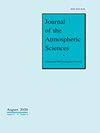水汽和温度在热带东北太平洋和非洲东风波热力学中的作用
IF 2.8
3区 地球科学
Q2 METEOROLOGY & ATMOSPHERIC SCIENCES
引用次数: 0
摘要
基于经验正交函数和羽流浮力框架,研究了热带非洲和东北太平洋东风波(分别为AEW和PEW)中与对流相关的热力学过程。线性回归分析揭示了EWs中温度、湿度、浮力和降水量之间的关系。在AEW和PEW中,羽流浮力与降雨量高度相关,并且ERA5中基于浮力的降雨量诊断与降雨量之间存在接近1:1的关系。仔细检查湿度和温度对羽流浮力的贡献,可以发现温度和湿度对AEW浮力的贡献大致相等,而湿度主导着PEW浮力的分布。为了了解东风波中温度和湿度的相对振幅,进行了尺度分析。研究发现,相对于AEW,温度对PEW热力学的贡献较小,这与它们较慢的传播速度有关,这使得PEW能够更稳健地调整到弱温度梯度(WTG)平衡。浮力分析和尺度分析的一致性表明,PEW是水分模式:水蒸气在其热力学中起主导作用的波。另一方面,AEW是温度和湿度在其热力学中扮演相似角色的混合波。本文章由计算机程序翻译,如有差异,请以英文原文为准。
The role of water vapor and temperature in the thermodynamics of Tropical Northeast Pacific and African easterly waves
The thermodynamic processes associated with convection in Tropical African and Northeastern Pacific Easterly Waves (AEWs and PEWs, respectively) are examined on the basis of Empirical Orthogonal Functions (EOFs) and a plume-buoyancy framework. Linear regression analysis reveals the relationship between temperature, moisture, buoyancy, and precipitation in EWs. Plume buoyancy is found to be highly correlated with rainfall in both AEWs and PEWs, and a near 1:1 relationship is found between a buoyancy-based diagnostic of rainfall and rainfall rates from ERA5. Close inspection of the contribution of moisture and temperature to plume buoyancy reveals that temperature and moisture contribute roughly equally to the buoyancy in AEWs, while moisture dominates the distribution of buoyancy in PEWs. A scale analysis is performed in order to understand the relative amplitudes of temperature and moisture in easterly waves. It is found that the smaller contribution of temperature to the thermodynamics of PEWs relative to AEWs is related to their slower propagation speed, which allows PEWs to more robustly adjust to weak temperature gradient (WTG) balance. The consistency of the buoyancy analysis and the scale analysis indicates that PEWs are moisture modes: waves in which water vapor plays a dominant role in their thermodynamics. AEWs, on the other hand, are mixed waves in which temperature and moisture play similar roles in their thermodynamics.
求助全文
通过发布文献求助,成功后即可免费获取论文全文。
去求助
来源期刊

Journal of the Atmospheric Sciences
地学-气象与大气科学
CiteScore
0.20
自引率
22.60%
发文量
196
审稿时长
3-6 weeks
期刊介绍:
The Journal of the Atmospheric Sciences (JAS) publishes basic research related to the physics, dynamics, and chemistry of the atmosphere of Earth and other planets, with emphasis on the quantitative and deductive aspects of the subject.
The links provide detailed information for readers, authors, reviewers, and those who wish to submit a manuscript for consideration.
 求助内容:
求助内容: 应助结果提醒方式:
应助结果提醒方式:


